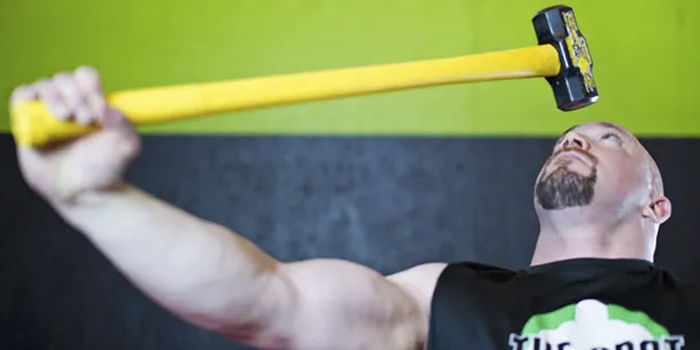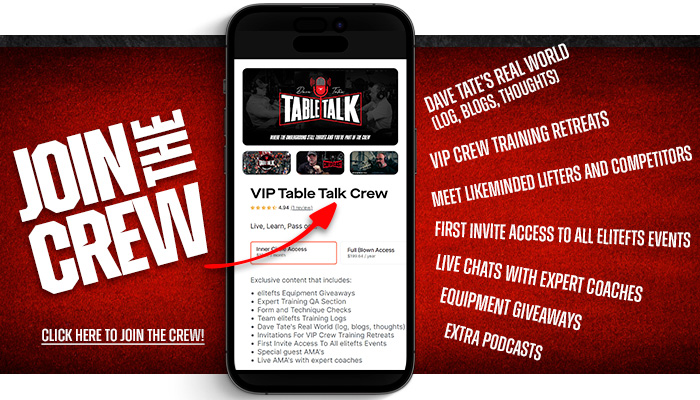
This program helped Brandon Smitley solve his grip issues for the deadlift and will help you do the same.
The most important advice I can give you about grip is to simply train your grip.
You know it will hold you back, so you must be training it.
If your glutes were weak, you would train them, so don't neglect your grip.
For deadlifting, you are looking at increasing your closed-hand supporting strength.
Timed Holds
Think of grip strength like any other strength. To make it stronger, you have to train it heavier. Adding 10-second holds or deadlift negatives builds grip endurance and doesn't make you any stronger. Just like doing high reps with a weight you can already bench will not make you any stronger. You want to avoid doing timed holds or high rep work, as this will thicken your hand and make it even harder to hold onto deadlifts.
Straps
A big thing I learned from Steve Goggins long ago is to train what you are training. If you are training Pin Pulls, put straps on and train Pin Pulls. Don't listen to the bullshit about "I never use straps." Those people are just so fucking weak that they can't pick anything up that outpaces their grip. So they use the "I don't use straps" as a crutch to make excuses for their pathetic deadlift.
I always use straps for Pull-ups, Pulldowns, and Shrugs. Heck, most of my back work is done with straps. Why? Because I'm training my back, not my grip. So don't listen to those a-holes about the straps; they can't deadlift with straps more than they can without, not because they have great grip, but because they have a weak deadlift.
I double overhand deadlifted 950 from a high pin, and when I went to 1050, I couldn't do it, but I could with straps.
Do I have a weak grip?
No, I have one of the best grips in the world. I just have a really strong back.
Grip Program to Never Drop a Deadlift
For this program, you will work your grip twice weekly until a meet starts getting close. Eight weeks out, knock it down to once per week to save your nervous system. Continue to do Day 1 over again for the eight weeks going into the meet. Don't do any grip work during the week of the meet—save your strength for the meet.
Remember that grip training is extremely hard on your nervous system, even though you don't have to do a lot of weight for certain types of lifts. Twice weekly grip training should be separated by at least two days, if not three.
Deciding what days you do it isn't as important, just that you do it. I do mine during rest periods for lower max effort work as it doesn't take any more time or waste my energy. If I'm going to do really heavy grip work (high rack pull), I do it on my upper days so that I'm not wearing out my back like I would be if it were on a lower day.
For these fat bar picks, you need to dig the webbing of your thumb into the bar hard and feel your whole hand, especially your thumb, squeezing the bar.
The below program is set up so that anyone can do it. You don't need a lot of special equipment, but I recommend getting the elitefts Grip Kit to vary your grip training more and work different elements.
With the below program, you will never have to worry about dropping a deadlift again.
Day 1 - Do on Upper Days (Support Grip, Thumb Strength)
Week 1 - (Max Single)
Double Overhand Deadlift from upper thigh level.
Place the pins at about 3-4" below your deadlift lockout.
Work your way up to a max.
You must lock your hips out with the weight and control it back to the pins for it to count (no dropping it after you lock it out).
Week 2 - (Max 3)
I assume you have an El Gordo or another thick axle bar. If not, get Fat Gripz and put them on a normal bar.
Set up the same as last week but drop the pin height one hole for the thicker bar.
Go to a max triple with the same scheme as before (double over - lockout/quick pause/down).
Week 3 - (Max Single - Hold)
Same setup as Week 1, but this time, lock your hips and hold the bar for a 5s count.
Week 4 - (Max Single)
El Gordo (axle) to a max single.
Week 5 - (Max 3)
Week 1 setup for a max triple.
Week 6 - (Max Single - Hold)
El gordo max for a 5s hold.
Week 7 - OFF
Week 8 - Retest Max From Week One
Day 2 - Do on Lower Days (Finger Strength, Pinch Dominate, Wrist Work)
Week 1 - (Max Single) Two-Hand Pinch Deadlift
Take two 45s (Must be metal. If your gym doesn't have metal plates, then you are officially not a man.), put them together with smooth sides out, and put a Prowler® pole through them.
Clip (velcro ones work best) on both sides of the poles, right next to the 45s. This will create a loadable 2-hand pinch deadlift setup.
Make sure to add weight equally on both sides as you go up. Anything over 150 pounds is respectable, over 200, and you got grip, so judge your weights accordingly.
Chalk the plates as that makes a big difference, and work up to a max single.
If you don't have Prowler® poles, you can put the plates on the end of a bar and use that to deadlift.
Week 2 - 8-Pound Sledge Lever Work - Hold a Sledge
Starting halfway down, put your forearm on a platform that is chest level or so.
Holding sledge head up, slowly lower sledge through a full range of wrist movement like you are casting a fishing pole.
Do this for 5 reps both sides. Move your hand down sledge slowly each set till you can't perform all 5 reps under control.
Do 5 sets total.
If you can do it from the very end of the sledge, move to a 10-pound sledge and send me a video because that's pretty good.
Week 3 - (Max 3) Two-Hand Pinch
Max triple without resetting your hands.
Week 4 - 8-Pound Sledge Work
Hold arm at 90 degrees at side, lock elbow to your side, and hold sledge halfway down from the head.
Rotate sledge from vertical to horizontal, internally and externally.
One internal/external turn is one rep.
Do 5 reps for 5 sets.
Each set try to move further down the sledge.
If you can do it at the very bottom of the 8-pound sledge, then you shouldn't have any problems holding onto a deadlift.
Week 5 - (Max Single Hold)
Two-hand pinch - 5s hold
Week 6 - 8-pound Sledge
Internal/External rotation 3x5, levering 3x5
Week 7 - OFF
Week 8 - Retest Two-Hand Pinch Deadlift
Header image credit © Columbus Alive
JL Holdsworth is a world champion powerlifter, published author, and former University of Kentucky strength and conditioning coach. With over 30,000 hours of practical experience and competition best lifts of a 905 lb. squat, 775 lb. bench press, and 804 lb. deadlift, JL is undoubtedly one of the strongest and most experienced strength and conditioning coaches in the industry.
JL has been the official speed and performance coach for the Major League Lacrosse, Ohio Machine, for the past three seasons. He is a highly sought-after speaker and has presented internationally on many topics relating to human performance. He regularly consults with major collegiate, NFL, and NHL programs, such as the New York Jets, St. Louis Blues, University of Clemson, and Ohio State University.
In 2010 he founded The Spot Athletics and has built that small private training facility into two 20,000sq. ft. locations in the Columbus, OH area. Along with his facilities, JL is the Co-Founder of Reflexive Performance Reset (RPR), an injury prevention and performance system being used by many top sports organizations around the world.











1 Comment